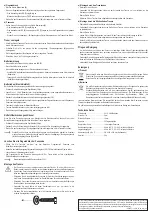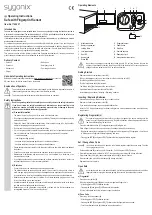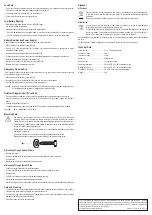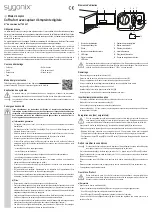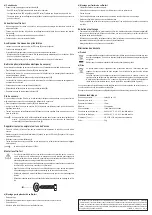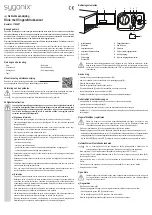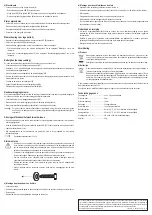
This is a publication by Conrad Electronic SE, Klaus-Conrad-Str. 1, D-92240 Hirschau (www.conrad.com). All rights
including translation reserved. Reproduction by any method, e.g. photocopy, microfilming, or the capture in electronic data
processing systems require the prior written approval by the editor. Reprinting, also in part, is prohibited. This publication
represents the technical status at the time of printing.
Copyright 2018 by Conrad Electronic SE.
*1760627_v1_0918_02_dh_m(3)_en
Lock Safe
• Do not over stuff the contents of the safe or you may damage the motor mechanism that drives the bolts.
• Close the door and rotate the lock/release knob
(4)
anti-clockwise.
• The locking bolts
(3)
will extend and lock the safe door.
• Check to make sure the door is properly closed.
Low Battery Warning
• When the battery levels are low, the red LED
(5)
will flash.
• You should replace the batteries.
• If the batteries fail before you have a chance to replace them:
- Connect the battery box as an external power source. See section “Battery Box” for further information.
- Use the emergency override key. See section “Emergency Override Key” for further information.
Battery Box (Backup Power Supply)
A backup power supply has been included in case the main supply fails.
• Slide the access compartment cover
(13)
off.
• Insert 4 x 1.5 V AA type batteries (not included) into the included battery box, taking care to match
polarities as shown inside.
• Insert the battery box plug into the power input jack
(12)
.
• The safe will power up so you can unlock it using stored fingerprints or by entering the pass code.
• Replace the batteries in the battery compartment
(2)
.
• Disconnect the battery box from the power input jack
(12)
.
• Replace the access compartment cover
(13)
.
Emergency Override Key
If you forget your pass code, the power supply or electrics fail, you can still access the contents of your safe
box using the emergency override key.
• Slide the access compartment cover
(13)
off.
• Insert the key into the override key hole
(11)
and turn all the way anti-clockwise.
• Turn the lock/release knob
(4)
clockwise to open the safe door.
Make sure the key is turned all the way anti-clockwise, you may need to gently jiggle the key if
the lock/release knob
(4)
does not disengage the locking bolts
(3)
.
Delete All Fingerprint(s) / Pass Code
• Open the safe door using one of three methods; fingerprint, pass code or emergency override key
• Press and hold down the initialization button
(1)
until the green LED
(7)
blinks 15 times and a beep is
heard.
• Release the initialization button
(1)
.
• All fingerprints and pass code have been deleted. The safe has returned to original factory settings.
Factory default pass code is “1234”
Mounting Safe
• The safe may be mounted to a vertical or horizontal surface e.g. wall or floor. When wall
mounting, make sure the fixture can handle the weight of the safe including the contents.
Failure to do so could result in the safe falling and damaging property and or causing injury.
• Check that the provided screws are appropriate for the type of surface you intend to attach the
safe to. If in doubt consult a professional.
• Before drilling, always check for concealed wires or pipes beneath the surface that could be
damaged or cause harm.
• Use a 6 mm diameter bit to drill holes for the supplied hexagonal head screws.
• Slide washers around screws before inserting through the safe mounting holes.
a) Mounting Through Bottom Of Safe
• Remove the carpet.
• Use the predrilled holes on the bottom of the safe to mark where to place the screws.
• Drill the holes.
• Mount the safe using the provided washers and screws.
b) Mounting Through Back Of Safe
• Check the vertical surface for structural soundness.
• Use the predrilled holes on the side of the safe to mark where to place the screws.
• Drill the holes.
• For safety, ask someone help you hold the safe during mounting.
• Mount the safe using the provided washers and screws.
• Test the strength of the mounted safe to make sure it does not fall from the vertical surface after letting go.
Care and Cleaning
• To maximize the security and performance of the safe, keep the fingerprint sensor
(8)
clean. Use a soft dry,
fibre-free cloth to remove any smudges or prints after each use
• Do not use any aggressive cleaning agents, rubbing alcohol or other chemical solutions as they can cause
damage to the housing and malfunctioning.
• Clean the product with a dry, fibre-free cloth.
Disposal
a) Product
Electronic devices are recyclable waste and must not be disposed of in the household waste.
At the end of its service life, dispose of the product in accordance with applicable regulatory
guidelines.
Remove any inserted batteries and dispose of them separately from the product.
b) Batteries
You as the end user are required by law (Battery Ordinance) to return all used batteries.
Disposing of them in the household waste is prohibited.
Contaminated batteries are labeled with this symbol to indicate that disposal in the domestic
waste is forbidden. The designations for the heavy metals involved are: Cd = Cadmium, Hg =
Mercury, Pb = Lead (name on batteries, e.g. below the trash icon on the left).
Used batteries can be returned to collection points in your municipality, our stores or wherever batteries
are sold.
You thus fulfill your statutory obligations and contribute to the protection of the environment.
Technical Data
Power source ........................................ 4 x 1.5 V AA-type batteries
Thickness of door ................................. 3 mm
Thickness of body ................................. 1.5 mm
Memory ................................................. 32 fingerprints
Numeric code ....................................... 1 x 4 digit pass code
Operating conditions ............................. -20 to +60 °C, 40 – 85 % relative humidity
Storage conditions ................................ -20 to +60 °C, 40 – 85 % relative humidity
Dimensions (W x H x D) ....................... 310 x 200 x 200 mm (outer dimensions)
Weight .................................................. 5 kg


